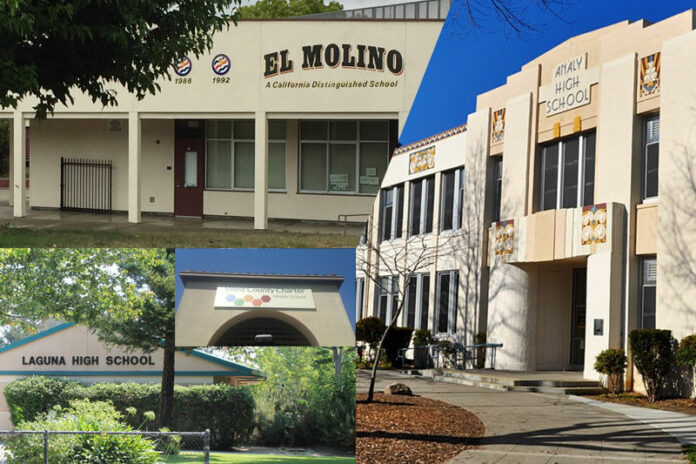Wednesday’s town hall of the West Sonoma County Union High School District revealed a board pressured by the Sonoma County Office of Education (SCOE) to come up with a plan and a community barely catching up on the likelihood of consolidation.
The next and final town hall for public input at this time is scheduled for Wednesday, Nov. 4. The board expanded meeting accessibility from requiring a Zoom account to include a YouTube livestream.
Looming over the board is a demand from SCOE that the struggling district deliver a Fiscal Recovery Plan by March 15, 2021 showing how it will secure $2 million in reductions or revenue by the fiscal year 2022-2023, said Jeff Ogston, chief business official.
The board considers consolidating Analy, El Molino and Laguna high schools onto either the Analy or El Molino campus to save an estimated $1.2 million potential annual cost savings.
Noting the district does not necessarily have to choose consolidation, Ogston phrased it as not so much “if” as “when.” He repeated from the previous town hall that the board could plan to consolidate in the 2022-2023 school year and figure out how to save another $800,000 by then, or plan for next year and get the estimated $1.2 million in each of the next two years.
Before reaching this assessment, Ogston reviewed how the district’s budget breaks down — literally.
Making a dollar out of 15 Cents
Ogston gave a rundown of how rising expenses in recent years have accelerated the conversation of consolidating. “It’s been a discussion, it’s been on the table for quite a few years, as long as I’ve been in the district, which is about fourteen years,” Ogston said.
He recapped his Oct. 21 presentation on how the district’s expenses outweigh its revenues on an annual basis without the one-time funds it usually uses to patch up holes in the budget.
The rising costs are non-public school and SCOE services (for students with special needs), transportation, property and liability insurance, salary increases and district contributions to state teachers’ and public employees’ retirement funds (CalSTRS and CalPRS).
On paper, Ogston said, the district expects the total revenue for the 2020-2021 school year to start at about $28.7 million. But the budget is actually about $24.6 million after state funds earmarked for transportation and CalSTRS contributions exit as expenses. Despite this year’s CARES Act funding and a new parcel tax, the budget loses $1.3 million moving forward from an expiring parcel tax.
The costs of a minimum emergency reserve, employee health benefits, supplies and operating expenses leave the district about $1.2 million short of its adopted budget for the 2020-2021 year, or “an operating deficit of a little over one million dollars every single year,” Ogston said.
“So, in the past, we’ve had, again, one-time money or we’ve had money that came in and we’ve used that to cover it. Or we’ve essentially had our savings, and we’ve gone through our savings. And so, when we talk about a structural deficit, this is what it is,” the official said.
Ogston said the district was very aware Proposition 15 could pass, but the amount of additional funding has yet to be determined. The $1.2 million some suggest is only the high estimate, with the low side trailing around $670,000 a year, he said.
“And obviously if it doesn’t pass, then it’s zero dollars a year, so it’s tough to count on right now,” he added.
Ogston said his bigger concern was the proposition’s implementation because it could take years to assess properties and overcome legal challenges, phasing in around the 2022-2023 school year and not fully implemented until the 2025-2026 year.
In the meantime, he said, the district has exhausted many options after cutting staff, bus routes and more and learned other solutions would not save enough to dig them out of the hole. And the district has until December to tell SCOE how it’s going to come up with the money.
“This year, we’re okay. Next year, it starts to run into that savings and that one-time money. And then in 2022 and 2023, we’re projected to be about $2 million short. And we really just don’t have $2 million of cuts we can make,” Ogston said.
Two million dollars is the equivalent of about 20 teachers, he said. “And there’s just no way we could reduce programs at that level and still provide the education that we want to for our kids.”
On top of these financial woes, Ogston said the state is deferring payments to schools and even consolidating would not fix all of the district’s problems.
Community Members Respond
Dan Blake, director of continuous improvement at SCOE, moderated the Q&A and public comment sessions for the over 500 community members he said were in attendance.
Parents were especially frustrated with what they described as a lack of transparency and accessibility to discussions and committees leading up to consolidation shaping into the dominant solution.
Other concerns resurfaced from the previous town hall, like meeting social and learning needs of students more suited to small schools like Analy, whether the district could reverse its decision to consolidate if it came up with the funds later and the possibility that new families moving into the region could boost enrollment.
Many attendees requested the board delay its decision until it conducted more detailed studies on impacts and that it explore what leniency SCOE might offer. Others voiced concern about possible legal weaknesses of rushing to consolidate.
One parent said she contacted Senator Mike McGuire’s office and sought to clarify whether the district had reached out to the county and state for aid. Board member Kellie Noe said she had been in conversation with McGuire’s office for a year regarding the consolidation and fiscal challenges.
Lynda Hopkins, Sonoma County 5th District Supervisor, said she wanted to inform the board and superintendent that she would be meeting with McGuire and Assemblymember Jim Wood this week to advocate for more funding for the district, “in hopes of potentially creating some kind of a bridge that would allow us a little more time to plan out and discuss this decision.”
Hopkins continued, “I also want to let you all know that you will be receiving a formal comment letter from the county tomorrow [Thursday] signed by Permit Sonoma Director Tennis Wick raising some issues and some concerns about CEQA.” CEQA stands for the California Environmental Quality Act.
She said CEQA applies to the decision to consolidate, contrary to a slide from the Oct. 7 presentation that said no law governs school site closures.
“I’m concerned that the way the district is proceeding is not in compliance with CEQA because you are proposing essentially segmentation, or piecemealing of a project, setting up a potential lawsuit for the district,” she said. Hopkins said a vacated site could also contribute to urban decay.
The state’s “Closing a School Best Practices Guide” and in-depth studies comparing impacts of moving the combined student body to either site, like CEQA, would enter the equation following the board’s decision to consolidate at all, according to the Oct. 7 presentation featuring attorney Phil Henderson of Orbach Huff Suarez & Henderson.
Adam Parks, co-chair of the West Sonoma County Schools Community Action Coalition, also returned to say the realities of declining enrollment and stacked odds needed to be faced. “I’m really disheartened by the previous comments because we’re out of options,” he said.
“Prop 15 is years away even if it did pass. Bridge money only prolongs the inevitable consolidation that we’re going to need to do. So, I implore everybody that’s paying attention tonight to start thinking of this in terms of what are the positives, what can we glean out of this,” Parks said.
One of the biggest concerns raised was how the board planned to transport students already traveling far distances from rural areas like Cazadero and Fort Ross if the Analy site in Sebastopol was chosen over El Molino in Forestville.
“And I know this is a very tricky situation, but I do think not utilizing the El Molino site has some detrimental effects that may be really bad for those kids that are far away,” said Michelle Rutherford, parent of an El Molino student. “It’s so hard. I actually lived in Jenner when I had a son who went to school out here. It is exhausting.”
Superintendent Toni Beal said transportation and busing would be part of the second phase of the consolidation conversation, including research on costs and impacts on either campus.









